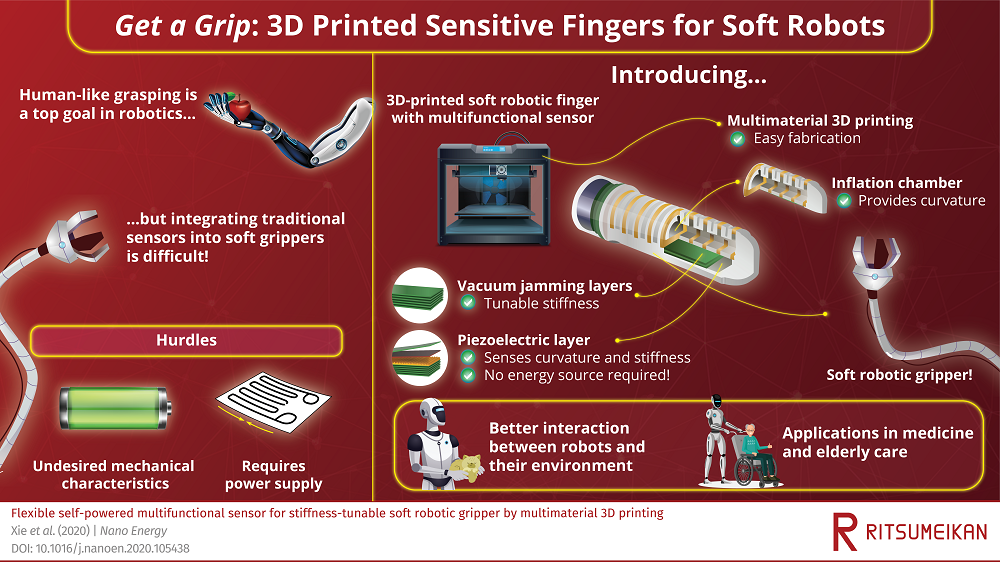
To develop a more human-like robotic gripper, it is necessary to provide sensing capabilities to the fingers. However, conventional sensors compromise the mechanical properties of soft robots. Now, scientists at Ritsumeikan University, Japan, design a 3D printable soft robotic finger containing a built-in sensor with adjustable stiffness. Their work represents a big step toward safer and more dexterous robotic handling, which will extend the applications of robots to fields such as health and elderly care.
Although robotics has reshaped and even redefined many industrial sectors, there still exists a gap between machines and humans in fields such as health and elderly care. For robots to safely manipulate or interact with fragile objects and living organisms, new strategies to enhance their perception while making their parts softer are needed. In fact, building a safe and dexterous robotic gripper with human-like capabilities is currently one of the most important goals in robotics.
One of the main challenges in the design of soft robotic grippers is integrating traditional sensors onto the robot’s fingers. Ideally, a soft gripper should have what’s known as proprioception—a sense of its own movements and position—to be able to safely execute varied tasks. However, traditional sensors are rigid and compromise the mechanical characteristics of the soft parts. Moreover, existing soft grippers are usually designed with a single type of proprioceptive sensation; either pressure or finger curvature.
To overcome these limitations, scientists at Ritsumeikan University, Japan, have been working on novel soft gripper designs under the lead of Associate Professor Mengying Xie. In their latest study published in Nano Energy, they successfully used multimaterial 3D printing technology to fabricate soft robotic fingers with a built-in proprioception sensor. Their design strategy offers numerous advantages and represents a large step toward safer and more capable soft robots.

The soft finger has a reinforced inflation chamber that makes it bend in a highly controllable way according to the input air pressure. In addition, the stiffness of the finger is also tunable by creating a vacuum in a separate chamber. This was achieved through a mechanism called vacuum jamming, by which multiple stacked layers of a bendable material can be made rigid by sucking out the air between them. Both functions combined enable a three-finger robotic gripper to properly grasp and maintain hold of any object by ensuring the necessary force is applied.
Most notable, however, is that a single piezoelectric layer was included among the vacuum jamming layers as a sensor. The piezoelectric effect produces a voltage difference when the material is under pressure. The scientists leveraged this phenomenon as a sensing mechanism for the robotic finger, providing a simple way to sense both its curvature and initial stiffness (prior to vacuum adjustment). They further enhanced the finger’s sensitivity by including a microstructured layer among the jamming layers to improve the distribution of pressure on the piezoelectric material.
The use of multimaterial 3D printing, a simple and fast prototyping process, allowed the researchers to easily integrate the sensing and stiffness-tuning mechanisms into the design of the robotic finger itself. “Our work suggests a way of designing sensors that contribute not only as sensing elements for robotic applications, but also as active functional materials to provide better control of the whole system without compromising its dynamic behavior,” says Prof Xie. Another remarkable feature of their design is that the sensor is self-powered by the piezoelectric effect, meaning that it requires no energy supply—essential for low-power applications.
Overall, this exciting new study will help future researchers find new ways of improving how soft grippers interact with and sense the objects being manipulated. In turn, this will greatly expand the uses of robots, as Prof Xie indicates: “Self-powered built-in sensors will not only allow robots to safely interact with humans and their environment, but also eliminate the barriers to robotic applications that currently rely on powered sensors to monitor conditions.”
Let’s hope this technology is further developed so that our mechanical friends can soon join us in many more human activities!

















